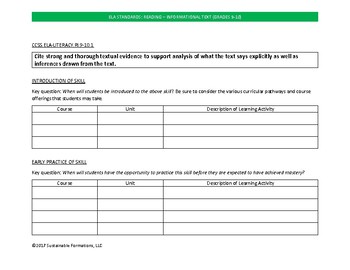CCSS Reading Informational Text Grades 9-10 Curriculum Template
Sustainable Formations
0 Followers
Grade Levels
9th - 10th, Homeschool
Resource Type
Standards
CCSSRI.9-10.1
CCSSRI.9-10.2
CCSSRI.9-10.3
CCSSRI.9-10.4
CCSSRI.9-10.5
Formats Included
- PDF
Pages
20 pages
Sustainable Formations
0 Followers
Description
Need a tool to document your current compliance with ELA Common Core standards? Are you in a curriculum review process? Interested in taking a closer look at your informational text instruction? This document identifies the ELA Reading Informational Text standards for grade 9-10 and matches them with templates that will track when and how you will: introduce the new skill, offer practice opportunities, and expect mastery.
This document only focuses on ELA Reading Informational Text standards, a subset of all the ELA standards for grades 9-10. If you are looking for all of the ELA standards for this grade level, check out the bundled product.
Finally, please note that this tool is designed for curricular assessment, revision, and planning (and not as a tracking tool for individual student performance).
This document only focuses on ELA Reading Informational Text standards, a subset of all the ELA standards for grades 9-10. If you are looking for all of the ELA standards for this grade level, check out the bundled product.
Finally, please note that this tool is designed for curricular assessment, revision, and planning (and not as a tracking tool for individual student performance).
Total Pages
20 pages
Answer Key
N/A
Teaching Duration
N/A
Report this resource to TPT
Reported resources will be reviewed by our team. Report this resource to let us know if this resource violates TPT’s content guidelines.
Standards
to see state-specific standards (only available in the US).
CCSSRI.9-10.1
Cite strong and thorough textual evidence to support analysis of what the text says explicitly as well as inferences drawn from the text.
CCSSRI.9-10.2
Determine a central idea of a text and analyze its development over the course of the text, including how it emerges and is shaped and refined by specific details; provide an objective summary of the text.
CCSSRI.9-10.3
Analyze how the author unfolds an analysis or series of ideas or events, including the order in which the points are made, how they are introduced and developed, and the connections that are drawn between them.
CCSSRI.9-10.4
Determine the meaning of words and phrases as they are used in a text, including figurative, connotative, and technical meanings; analyze the cumulative impact of specific word choices on meaning and tone (e.g., how the language of a court opinion differs from that of a newspaper).
CCSSRI.9-10.5
Analyze in detail how an author’s ideas or claims are developed and refined by particular sentences, paragraphs, or larger portions of a text (e.g., a section or chapter).





